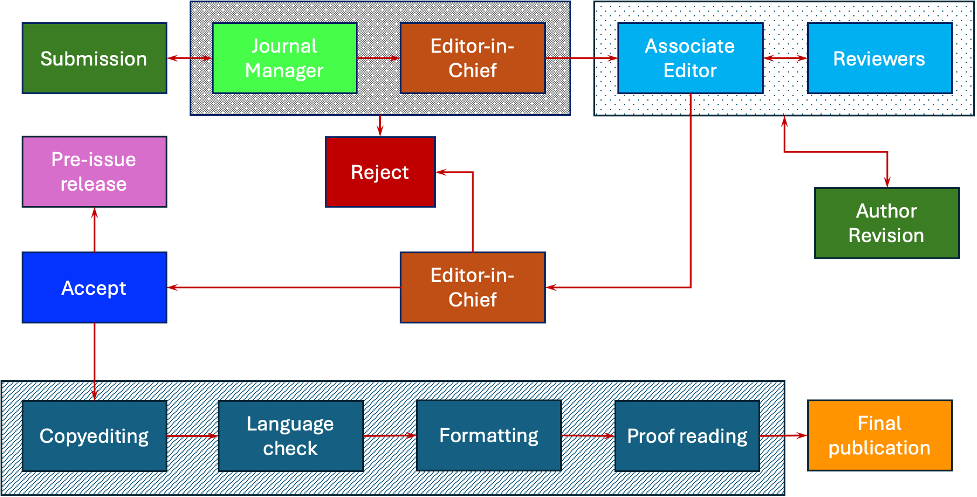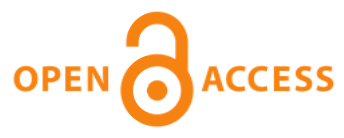Editorial Policy
Responsibilities of the Editorial Board Members
The editorial board members have the following responsibilities:
- Commitment to the Journal’s Mission: The members shall be committed to supporting the journal’s mission and vision of publishing high-quality, peer-reviewed research in the broader context of environmental science, health, and sustainability.
- Peer Review Process: The members shall actively participate in the peer review process by reviewing manuscripts in a timely fashion and providing constructive feedback to authors. Additionally, they shall participate in the manuscript handling process by soliciting external reviewers for independent feedback and recommending their judgment to the editor-in-chief.
- Confidentiality: The members shall maintain a high level of confidentiality regarding submitted manuscripts, reviewers’ identities (unless they choose to reveal their name to authors), and editorial discussions.
- Ethical Standards: The members shall uphold the highest ethical standards in research and publication in line with COPE Guidelines, ensuring the integrity of the peer review process and transparency in handling conflicts of interest.
- Contribution to Journal Development: The members shall assist in identifying potential contributors and recommending topics of relevance to the field for regular and/or special issues.
- Timeliness: The members shall respond promptly to editorial duties, including manuscript reviews and processing, and attend editorial board meetings or calls when possible.
- Adherence to Policies: The members shall follow the journal’s editorial and publication policies, ensuring alignment with its goals and standards.
Editorial Processes
The journal follows a single-blind peer review model, balancing transparency with fair assessment to uphold the highest standards. Reviewers are encouraged to reveal their names to the authors post-acceptance of the manuscript, but they can remain anonymous. The journal article includes the names of the handling editor and reviewer (if they agree) in the published version. This ensures the confidence of our readers.
The detailed editorial workflow is shown below:

- All submissions undergo initial editorial screening by the journal manager to ensure that the submitted manuscript meets the journal’s basic requirements, such as whether the submission follows the author's guidelines. AI detection checks were also performed in this stage. The manuscript also undergoes a plagiarism check by the journal manager and confirms whether the manuscript meets the journal’s quality control of a similarity index of less than 20%. Authors are informed of any changes that are required at this stage. If any changes and formatting are required, the submissions are sent back to the authors for recommended changes before assigning the manuscript to the Editor-in-Chief (EIC).
- EIC is responsible for checking the quality, including thorough plagiarism checks and relevance to the journal’s scope. The EIC determines whether the manuscript has merit and novelty to go through the peer-review process. The EIC can either reject the manuscript or assign that to an Associate Editor (AE) based on the subject matter of the manuscript. The entire process is normally completed within one week from submission unless the manuscript does not pass the initial editorial screening.
- The peer review process is handled by the AE. The AE sends the manuscripts to two or more external reviewers for evaluation under the single-blind peer review model. Reviewers are typically given 3 weeks to complete their assessments and submit their detailed recommendations to the associate editor (ie. handling editor). The AE checks thoroughly the reviewer’s comments and recommendations and makes his initial determination whether to ask for revision or recommend rejection of the manuscript. In cases of required revisions, the AE with the help of the journal manager sends authors detailed feedback from reviewers to help guide the revisions. Authors are typically given 1–2 weeks to address minor comments. For substantial revisions, authors may receive 3-4 weeks to make changes and resubmit. The revised manuscript may undergo an additional round of review if substantial changes are made or if new concerns arise. Once all revisions are satisfactorily addressed, the manuscript undergoes a final editorial review. The AE then makes a final recommendation on the acceptance and rejection of the manuscript to the EIC. This process normally takes 6 to 8 weeks to finish.
- The EIC reviews the AE’s recommendations and makes the final decision. Authors are notified whether their manuscript is accepted or rejected.
- Accepted manuscripts proceed to the production stage for copyediting, language check, formatting, and proofreading and are typically published in the next available issue. Online pre-publication may be available before the issue's release. The production process is done by the copyeditor. During the production stages, authors are required to check and confirm both copyedited manuscripts as well as proofread the final version of the manuscript before being published online.
Manuscript Acceptance Criteria
Manuscripts should be written in a well-structured manner, with a logical flow and clear language, and must align with the journal’s core focus areas. The abstract should summarize the main findings, while the introduction, methodology, experimental, results, and discussion should be coherent. A thorough review of the relevant literature is required, with citations formatted according to the journal’s reference style and proper credit given to prior research.
Research must be based on reproducible study designs, with transparent data collection and analysis. The methodology should allow replication, and results must be clearly presented, accurate, and supported by appropriate statistical analyses.











